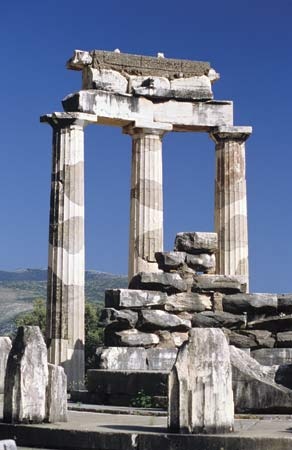tholos
architecture
plural tholoi, Latin tholus, plural tholi, also called beehive tomb

 in ancient Greek architecture, a circular building with a conical or vaulted roof and with or without a peristyle, or surrounding colonnade. In the Mycenaean period, tholoi were large ceremonial tombs, sometimes built into the sides of hills; they were beehive-shaped and covered by a corbeled arch. In classical Greece, the tholos at Delphi had a peristyle; the tholos in Athens, serving as a dining hall for the Athenian Senate, had no outside columns. The tholos at Epidaurus, designed by Polyclitus, was a circular chamber with a Doric colonnade outside and a Corinthian within; it contained exquisite carvings. The foundations were a series of concentric walls with doors and partitions that made a subterranean labyrinth. The tholos at Olympia, known as the Philippeum, was a round building of the Ionic order, with Corinthian half columns on the inside; it was erected by Philip II of Macedon to commemorate his victory over the Greeks at Chaeronea in 338 BC.
in ancient Greek architecture, a circular building with a conical or vaulted roof and with or without a peristyle, or surrounding colonnade. In the Mycenaean period, tholoi were large ceremonial tombs, sometimes built into the sides of hills; they were beehive-shaped and covered by a corbeled arch. In classical Greece, the tholos at Delphi had a peristyle; the tholos in Athens, serving as a dining hall for the Athenian Senate, had no outside columns. The tholos at Epidaurus, designed by Polyclitus, was a circular chamber with a Doric colonnade outside and a Corinthian within; it contained exquisite carvings. The foundations were a series of concentric walls with doors and partitions that made a subterranean labyrinth. The tholos at Olympia, known as the Philippeum, was a round building of the Ionic order, with Corinthian half columns on the inside; it was erected by Philip II of Macedon to commemorate his victory over the Greeks at Chaeronea in 338 BC.- Almirante Brown
- Almohads
- almond
- Almond, Gabriel Abraham
- almoner
- Almon, John
- almonry school
- Almora
- Almoravids
- Almqvist, Carl Jonas Love
- almshouse
- al- Mubarrad
- almucantar
- Al- Mufaḍḍalīyāt
- al- Muhallab ibn Abī Ṣufrā
- Al- Mukallā
- al- Mukhtār ibn Abū ʿUbayd al-Thaqafi
- al- Muktafī
- al- Muqannaʿ
- al- Muqtafī
- al- Mustanṣir
- al- Mustaʿṣim
- al- Mutanabbī
- al- Mutawakkil
- Al- Muʿallaqāt